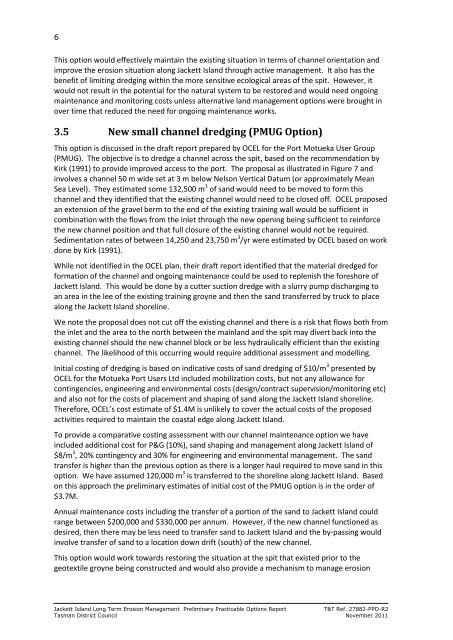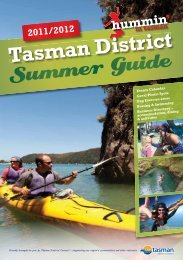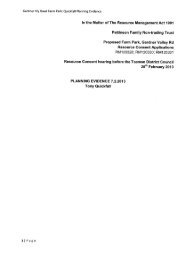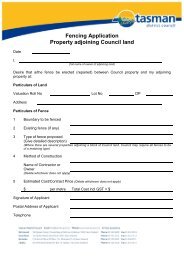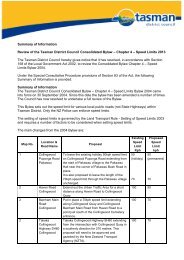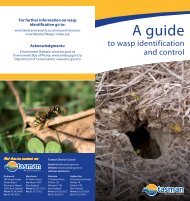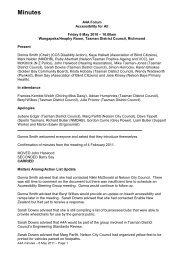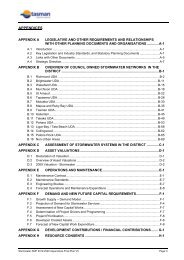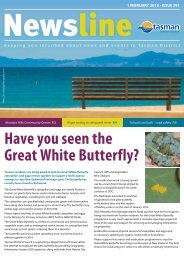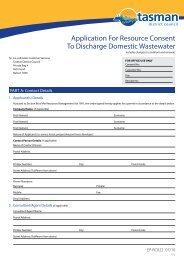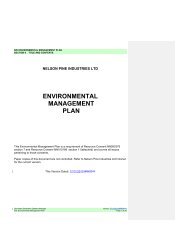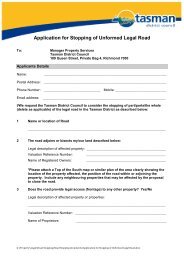RESC11-12-02 Port Motueka Groyne-Jackett Island Erosion ...
RESC11-12-02 Port Motueka Groyne-Jackett Island Erosion ...
RESC11-12-02 Port Motueka Groyne-Jackett Island Erosion ...
You also want an ePaper? Increase the reach of your titles
YUMPU automatically turns print PDFs into web optimized ePapers that Google loves.
6<br />
This option would effectively maintain the existing situation in terms of channel orientation and<br />
improve the erosion situation along <strong>Jackett</strong> <strong>Island</strong> through active management. It also has the<br />
benefit of limiting dredging within the more sensitive ecological areas of the spit. However, it<br />
would not result in the potential for the natural system to be restored and would need ongoing<br />
maintenance and monitoring costs unless alternative land management options were brought in<br />
over time that reduced the need for ongoing maintenance works.<br />
3.5 New small channel dredging (PMUG Option)<br />
This option is discussed in the draft report prepared by OCEL for the <strong>Port</strong> <strong>Motueka</strong> User Group<br />
(PMUG). The objective is to dredge a channel across the spit, based on the recommendation by<br />
Kirk (1991) to provide improved access to the port. The proposal as illustrated in Figure 7 and<br />
involves a channel 50 m wide set at 3 m below Nelson Vertical Datum (or approximately Mean<br />
Sea Level). They estimated some 132,500 m 3 of sand would need to be moved to form this<br />
channel and they identified that the existing channel would need to be closed off. OCEL proposed<br />
an extension of the gravel berm to the end of the existing training wall would be sufficient in<br />
combination with the flows from the inlet through the new opening being sufficient to reinforce<br />
the new channel position and that full closure of the existing channel would not be required.<br />
Sedimentation rates of between 14,250 and 23,750 m 3 /yr were estimated by OCEL based on work<br />
done by Kirk (1991).<br />
While not identified in the OCEL plan, their draft report identified that the material dredged for<br />
formation of the channel and ongoing maintenance could be used to replenish the foreshore of<br />
<strong>Jackett</strong> <strong>Island</strong>. This would be done by a cutter suction dredge with a slurry pump discharging to<br />
an area in the lee of the existing training groyne and then the sand transferred by truck to place<br />
along the <strong>Jackett</strong> <strong>Island</strong> shoreline.<br />
We note the proposal does not cut off the existing channel and there is a risk that flows both from<br />
the inlet and the area to the north between the mainland and the spit may divert back into the<br />
existing channel should the new channel block or be less hydraulically efficient than the existing<br />
channel. The likelihood of this occurring would require additional assessment and modelling.<br />
Initial costing of dredging is based on indicative costs of sand dredging of $10/m 3 presented by<br />
OCEL for the <strong>Motueka</strong> <strong>Port</strong> Users Ltd included mobilization costs, but not any allowance for<br />
contingencies, engineering and environmental costs (design/contract supervision/monitoring etc)<br />
and also not for the costs of placement and shaping of sand along the <strong>Jackett</strong> <strong>Island</strong> shoreline.<br />
Therefore, OCEL’s cost estimate of $1.4M is unlikely to cover the actual costs of the proposed<br />
activities required to maintain the coastal edge along <strong>Jackett</strong> <strong>Island</strong>.<br />
To provide a comparative costing assessment with our channel maintenance option we have<br />
included additional cost for P&G (10%), sand shaping and management along <strong>Jackett</strong> <strong>Island</strong> of<br />
$8/m 3 , 20% contingency and 30% for engineering and environmental management. The sand<br />
transfer is higher than the previous option as there is a longer haul required to move sand in this<br />
option. We have assumed <strong>12</strong>0,000 m 3 is transferred to the shoreline along <strong>Jackett</strong> <strong>Island</strong>. Based<br />
on this approach the preliminary estimates of initial cost of the PMUG option is in the order of<br />
$3.7M.<br />
Annual maintenance costs including the transfer of a portion of the sand to <strong>Jackett</strong> <strong>Island</strong> could<br />
range between $200,000 and $330,000 per annum. However, if the new channel functioned as<br />
desired, then there may be less need to transfer sand to <strong>Jackett</strong> <strong>Island</strong> and the by-passing would<br />
involve transfer of sand to a location down drift (south) of the new channel.<br />
This option would work towards restoring the situation at the spit that existed prior to the<br />
geotextile groyne being constructed and would also provide a mechanism to manage erosion<br />
<strong>Jackett</strong> <strong>Island</strong> Long Term <strong>Erosion</strong> Management Preliminary Practicable Options Report<br />
T&T Ref. 27882-PPO-R2<br />
Tasman District Council November 2011


